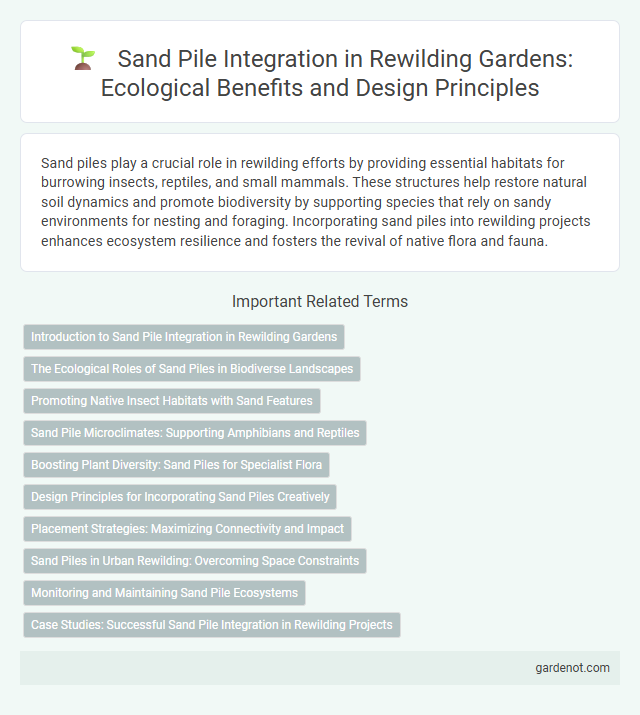Sand piles play a crucial role in rewilding efforts by providing essential habitats for burrowing insects, reptiles, and small mammals. These structures help restore natural soil dynamics and promote biodiversity by supporting species that rely on sandy environments for nesting and foraging. Incorporating sand piles into rewilding projects enhances ecosystem resilience and fosters the revival of native flora and fauna.
Introduction to Sand Pile Integration in Rewilding Gardens
Sand pile integration in rewilding gardens enhances soil biodiversity by providing a natural habitat for insects, microorganisms, and small reptiles essential in ecological restoration. These textured mounds aid water drainage and create microclimates that support native plant germination and growth. Incorporating sand piles replicates natural terrain features, promoting habitat complexity critical for sustaining resilient ecosystems.
The Ecological Roles of Sand Piles in Biodiverse Landscapes
Sand piles create unique microhabitats that support specialized flora and fauna, enhancing biodiversity in rewilded ecosystems. They facilitate soil aeration and water infiltration, promoting nutrient cycling crucial for plant growth. These structures also act as nesting grounds for insects and birds, contributing to the ecological complexity of natural landscapes.
Promoting Native Insect Habitats with Sand Features
Sand piles provide essential microhabitats that support native insect populations by offering nesting sites for solitary bees, wasps, and other beneficial arthropods. These features enhance soil aeration and facilitate natural pest control, contributing to ecosystem resilience in rewilding projects. Incorporating sand piles into restoration efforts promotes biodiversity and strengthens the integrity of native insect communities.
Sand Pile Microclimates: Supporting Amphibians and Reptiles
Sand piles create unique microclimates with varying temperature and moisture levels, providing essential refuges for amphibians and reptiles. These microhabitats offer shelter, breeding sites, and thermoregulation spots, enhancing local biodiversity and species survival. Research shows sand pile microclimates significantly increase habitat suitability for rare and endangered herpetofauna.
Boosting Plant Diversity: Sand Piles for Specialist Flora
Sand piles create unique microhabitats that support specialist flora often unable to thrive in typical soil conditions. These nutrient-poor, well-drained substrates encourage the growth of rare, drought-tolerant plant species, significantly boosting plant diversity within rewilding projects. Incorporating sand piles enhances ecological complexity and promotes resilience by providing refuge for specialized plants critical to maintaining biodiversity.
Design Principles for Incorporating Sand Piles Creatively
Design principles for incorporating sand piles creatively emphasize natural integration, texture variation, and habitat enhancement to support biodiversity. Sand piles should mimic natural formations, use graded particle sizes to create microhabitats, and be positioned to facilitate species-specific shelter and nesting opportunities. Strategic placement considers sun exposure, moisture retention, and connectivity with existing landscape elements to maximize ecological benefits.
Placement Strategies: Maximizing Connectivity and Impact
Strategic placement of sand piles within rewilding landscapes enhances habitat connectivity by creating microhabitats that support diverse species, including invertebrates and ground-nesting birds. Positioning sand piles near existing ecological corridors maximizes their ecological impact, facilitating species movement and genetic exchange. Optimizing placement based on landscape topography and species-specific habitat needs significantly boosts restoration outcomes and biodiversity resilience.
Sand Piles in Urban Rewilding: Overcoming Space Constraints
Sand piles in urban rewilding serve as vital microhabitats that support biodiversity by providing shelter and breeding grounds for insects, reptiles, and small mammals. These sand piles effectively utilize limited city spaces, transforming underused areas into functional ecosystems that enhance urban green infrastructure. Integrating sand piles into urban planning helps overcome space constraints while promoting ecological connectivity and resilience within densely built environments.
Monitoring and Maintaining Sand Pile Ecosystems
Monitoring and maintaining sand pile ecosystems require regular assessment of soil moisture, vegetation cover, and species diversity to ensure habitat stability and promote biodiversity. Implementing remote sensing technology and in-situ sampling helps track ecological changes and detect potential threats such as erosion or invasive species. Restoration efforts focus on controlled disturbance regimes and native plant reintroduction to sustain ecosystem functions and resilience.
Case Studies: Successful Sand Pile Integration in Rewilding Projects
Sand pile structures have been effectively integrated into rewilding projects to restore natural habitats and promote biodiversity. Case studies from the Netherlands and the UK demonstrate how these sand formations create microhabitats that support ground-nesting birds, insects, and rare plant species. This targeted use of sand piles enhances soil aeration and water retention, accelerating ecosystem recovery and fostering resilient wildlife populations.
Sand pile Infographic

 gardenot.com
gardenot.com